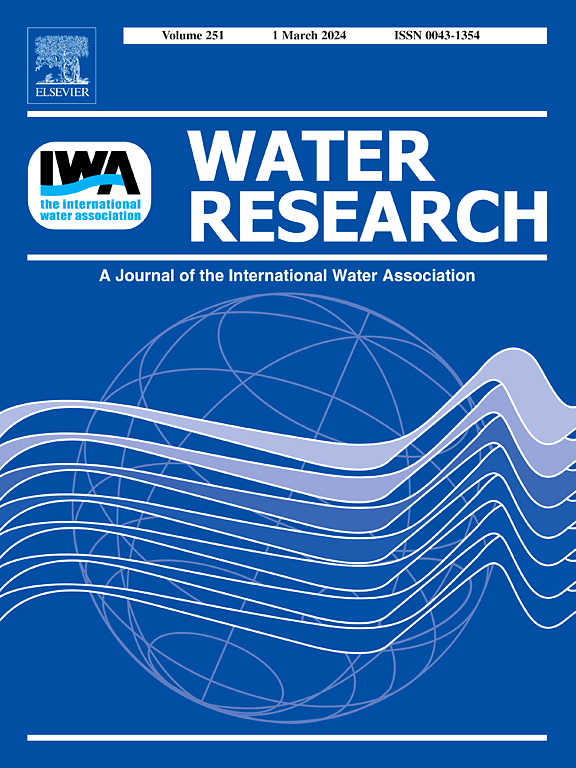纺织基超细纤维在空气和水环境中的老化
IF 12.4
1区 环境科学与生态学
Q1 ENGINEERING, ENVIRONMENTAL
引用次数: 0
摘要
纺织微纤维(MFs)是全球微塑料污染的主要来源。然而,人们对纺织基MFs的老化知之甚少。本研究探讨了白色(无颜料)和黑色(以炭黑为颜料)的纺织基聚对苯二甲酸乙二醇酯(PET) MFs在空气和水环境中的老化行为。采用紫外(UV)和等离子体老化模拟了MFs的短期和长期老化。结果表明,在空气和水环境中,白色基质比黑色基质表现出更明显的表面变化,形成更多的-OH键,氧碳比(O/C)增加。例如,在空气环境中,血浆老化过程中,白色MFs的O/C增加百分比为24.43%,而黑色MFs的O/C增加百分比为16.4%。进一步的研究阐明了驱动白色MFs更高程度老化的机制。结果表明,炭黑可以提高黑色复合材料的抗拉强度和硬度,从而抑制其老化过程。此外,MFs释放的溶解有机物(DOM)的激发-发射矩阵(EEM)分析,结合MFs在水环境中产生的活性氧(ROS)的检测,证实了炭黑是一种有效的抗衰老添加剂。它的保护作用,归因于紫外线和等离子体屏蔽和活性自由基捕获机制,导致白色MFs比黑色MFs老化程度更高。这些发现为预测不同颜色的纺织基MFs在空气和水环境中的老化行为提供了见解。本文章由计算机程序翻译,如有差异,请以英文原文为准。


Aging of textile-based microfibers in both air and water environments
Textile-based microfibers (MFs) are a predominant source of global microplastics (MPs) pollution. Yet, less is known about the aging of textile-based MFs. This study explored the aging behavior of textile-based polyethylene terephthalate (PET) MFs with white (without pigment) and black (with carbon black as pigment) colors in both air and water environments. Ultraviolet (UV) and plasma aging were carried out to simulate the short- and long-term aging of MFs. Results indicated that white MFs exhibited more pronounced surface changes, formed more -OH bonds, and showed a higher increase in the oxygen-to-carbon(O/C) ratio than black MFs in both air and water environments. For example, in the air environment, the percentage increase of O/C for white MFs was 24.43 %, compared to 16.4 % for black MFs during plasma aging process. Further investigations were conducted to elucidate the mechanisms driving higher degree of aging of white MFs. It was verified that the carbon black in the black MFs could enhance their tensile strength and hardness, thereby countering the aging process. Furthermore, excitation-emission-matrix (EEM) analysis of dissolved organic matter (DOM) released from MFs, combined with the detection of reactive oxygen species (ROS) generated by MFs in the water environment, confirmed that carbon black functioned as an effective anti-aging additive. Its protective role, attributed to UV and plasma shielding and reactive radical-trapping mechanisms, led to higher aging degree in white MFs compared to black MFs. These findings provide insights into predicting the aging behaviors of textile-based MFs with different colors in air and water environments.
求助全文
通过发布文献求助,成功后即可免费获取论文全文。
去求助
来源期刊

Water Research
环境科学-工程:环境
CiteScore
20.80
自引率
9.40%
发文量
1307
审稿时长
38 days
期刊介绍:
Water Research, along with its open access companion journal Water Research X, serves as a platform for publishing original research papers covering various aspects of the science and technology related to the anthropogenic water cycle, water quality, and its management worldwide. The audience targeted by the journal comprises biologists, chemical engineers, chemists, civil engineers, environmental engineers, limnologists, and microbiologists. The scope of the journal include:
•Treatment processes for water and wastewaters (municipal, agricultural, industrial, and on-site treatment), including resource recovery and residuals management;
•Urban hydrology including sewer systems, stormwater management, and green infrastructure;
•Drinking water treatment and distribution;
•Potable and non-potable water reuse;
•Sanitation, public health, and risk assessment;
•Anaerobic digestion, solid and hazardous waste management, including source characterization and the effects and control of leachates and gaseous emissions;
•Contaminants (chemical, microbial, anthropogenic particles such as nanoparticles or microplastics) and related water quality sensing, monitoring, fate, and assessment;
•Anthropogenic impacts on inland, tidal, coastal and urban waters, focusing on surface and ground waters, and point and non-point sources of pollution;
•Environmental restoration, linked to surface water, groundwater and groundwater remediation;
•Analysis of the interfaces between sediments and water, and between water and atmosphere, focusing specifically on anthropogenic impacts;
•Mathematical modelling, systems analysis, machine learning, and beneficial use of big data related to the anthropogenic water cycle;
•Socio-economic, policy, and regulations studies.
 求助内容:
求助内容: 应助结果提醒方式:
应助结果提醒方式:


